Understanding Auto Dethatchers for Healthy Lawns
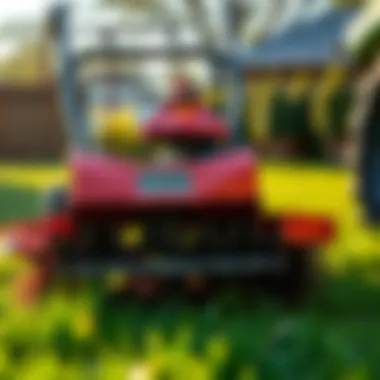
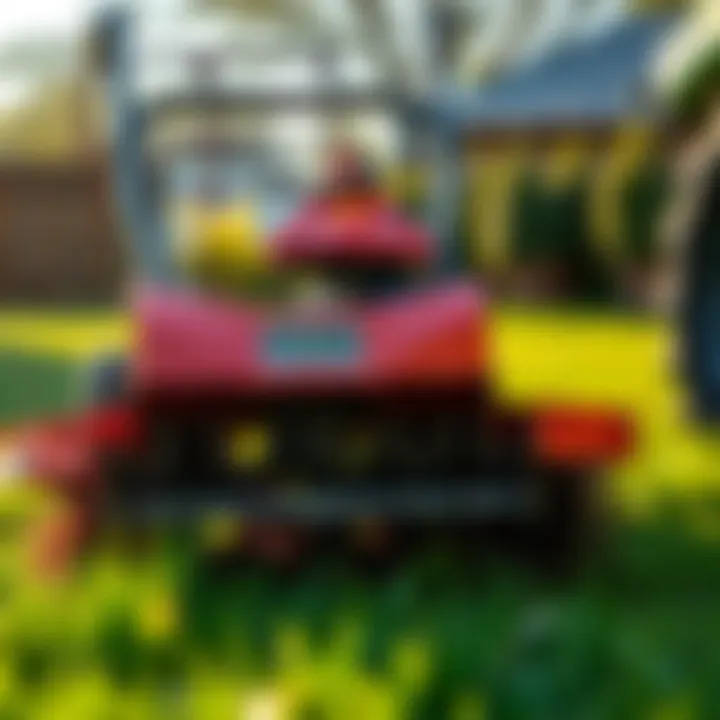
Intro
In the realm of lawn care, maintaining a lush and vibrant turf can feel akin to juggling flaming torches. It requires knowledge, skill, and precisely the right tools. An often-overlooked yet critical device in this landscaping toolkit is the auto dethatcher. These machines play a significant role in keeping lawns healthy by removing organic debris such as thatch, which can choke the life out of grass if allowed to accumulate.
Dethatching is not merely a chore; it’s a pivotal practice in lawn care. This article sets out to explore the intricacies of auto dethatchers, from their mechanics to their advantages. By understanding these devices deeply, both professionals and lawn enthusiasts can significantly enhance their landscaping practices. With this groundwork laid, let’s delve into the key insights surrounding the topic.
Prelims to Auto Dethatchers
Auto dethatchers play a pivotal role in the upkeep of lush and vibrant lawns, serving as essential tools for both backyard enthusiasts and professional landscapers. The importance of these machines cannot be overstated. They simplify the dethatching process, allowing for efficient removal of thatch while enhancing the overall health of the turf. In this article, we explore how auto dethatchers contribute significantly to maintaining healthy lawns, ensuring that grass can thrive under ideal conditions.
Definition of Dethatching
Dethatching refers to the process of removing thatch—a layer of organic material composed of dead grass, roots, and other debris that accumulates on the soil surface. When this layer becomes too thick, it can suffocate the grass roots, hindering water, nutrients, and air from penetrating the soil. Dethatching is vital in promoting proper airflow and healthy grass growth.
The Necessity of Dethatching
As the saying goes, "Out of sight, out of mind," but when it comes to lawn care, this is far from the truth. Ignoring thatch buildup can lead to serious consequences.
- Loss of Grass Quality: A healthy lawn is lush and vibrant, tolerating various weather conditions. When thatch becomes excessive, it creates a breeding ground for pests and diseases.
- Water Drainage Issues: Thatch can act like a sponge, soaking up water but failing to allow it to reach the roots. This hampers the lawn's ability to thrive, especially during dry spells.
- Nutrient Deficiencies: Just like plants need water, they require nutrients as well. A thick layer of thatch obstructs the effectiveness of fertilizers and other nutrients from reaching the grass’s roots, leading to poor growth.
By employing auto dethatchers in lawn care routines, homeowners and professional landscapers can ensure their grass receives the essentials it needs for robust growth. Through automated processes and mechanized precision, these devices significantly reduce the labor and time involved in dethatching, making it a manageable task for anyone serious about maintaining their lawns.
Understanding Thatch
Thatch is a term that many lawn care enthusiasts hear tossed around, but what exactly does it mean? In general, thatch refers to a layer of organic debris that accumulates between the soil surface and the green part of the grass. This layer is made up of dead grass, roots, and other organic matter. It can be a double-edged sword if not kept in check. On one hand, a certain amount of thatch can benefit the lawn by helping to retain moisture and providing habitat for beneficial microorganisms. However, excessive thatch can become a significant issue for the overall health of your lawn.
Understanding what constitutes thatch and recognizing the signs of its buildup is crucial for anybody invested in maintaining a lush and green landscape. If the thatch layer becomes too thick—typically more than half an inch—it can restrict water, nutrients, and air from reaching grass roots, leading to several lawn problems.
What Constitutes Thatch?
Thatch consists primarily of three components:
- Dead grass: Grass clippings from mowing that don't break down quickly can accumulate over time.
- Roots: The remnants of grass roots that haven’t fully decomposed can contribute to the thatch layer.
- Soil microorganisms: As these tiny organisms help in decomposing organic matter, their waste products can also contribute to thatch formation.
It's a mixed bag, really. A thin layer of thatch can be beneficial, acting like a sponge that holds moisture and a cushion for your grass. But, when it’s too thick, it can create a barrier that traps water and nutrients, leading to poor grass health.
Consequences of Excessive Thatch
When the thatch layer reaches excessive levels, the repercussions can be significant. Here are some adverse effects that can occur:
- Stunted Grass Growth: Thick thatch can suffocate the grass roots, causing them to become shallow and ineffective in taking up nutrients from the soil.
- Pest Attraction: Thick layers of thatch can create a cozy environment for pests like beetles and grubs. This not only affects grass vitality but can also lead to increased pesticide usage, which is not environmentally friendly.
- Disease Susceptibility: Excessive thatch provides a breeding ground for diseases like fungal infections, which can further weaken your lawn.
- Water Drainage Issues: A thick mat can impede the natural drainage of water, leading to puddles and potential root rot.
In essence, managing thatch is a balancing act. Too little may not provide the benefits you want, while too much can cause a world of headaches. Regular dethatching with an auto dethatcher can help maintain that optimal balance, ensuring your lawn stays healthy and vibrant.
"An ounce of prevention is worth a pound of cure." Keeping an eye on thatch levels and addressing issues before they escalate is vital for every lawn care aficionado.
Maintaining a well-balanced lawn requires constant attention to various factors, and understanding thatch is foundational. This knowledge not only empowers you to choose the right tools for your lawn care but also equips you to make better decisions for a sustainable landscape.
Types of Auto Dethatchers
Understanding different types of auto dethatchers is crucial for anyone looking to maintain a vibrant and healthy lawn. Each model has unique attributes that cater to specific needs, ensuring that lawn care enthusiasts can select the right tool for their particular situation. Knowing the distinctions not only enhances efficiency but also addresses the diverse environmental conditions and user preferences.
Electrical Models
Electrical auto dethatchers are often favored for residential use due to their ease of operation and low maintenance. These machines use an electric motor to power a series of blades that cut through the thatch layer without damaging the grass.
Key features of electrical models include:
- Lightweight and Compact: Many electrical dethatchers are designed to be easy to maneuver, making them user-friendly for those who might not have much experience.
- Quiet Operation: Unlike gas models, electrical dethatchers operate quietly, making them suitable for use early in the morning or late evening.
- No Fuel Costs: With rising fuel prices, running an electrical dethatcher reduces ongoing expenses for lawn care.


However, users must be located near power sources, which might limit usability in larger outdoor spaces.
Gas-Powered Options
When it comes to tackling larger lawns or stubborn thatch layers, gas-powered auto dethatchers stand out. Their robust engines provide ample power for intensive dethatching activities.
Benefits of gas-powered models are:
- Mobility: Since they don't need to be plugged into an outlet, gas dethatchers can traverse larger areas without the worry of tripping over cords.
- High Performance: They can efficiently manage thick thatch layers, making them suitable for more significant lawn issues and less frequent dethatching intervals.
- Durability: Generally, gas dethatchers are built to last and can handle tough conditions, which might make them a worthwhile investment over time.
However, they do come with certain drawbacks. The noise level is considerably higher, not to mention the necessity of maintenance like oil changes and spark plug replacements.
Manual vs. Auto Dethatching
When considering dethatching methods, a common debate arises between manual and auto dethatching. While both approaches aim to improve lawn health, their methodologies, effectiveness, and user experiences differ.
- Manual Dethatching: This process often involves using a rake or a handheld blade to remove thatch. Although it's cost-effective and offers exercise opportunities, it can be labor-intensive and time-consuming.
- Auto Dethatching: In contrast, auto dethatching tools allow users to cover expansive areas in significantly less time. The machines automate the dethatching process, ensuring consistent depth and coverage.
Ultimately, the choice may depend on lawn size, user ability, and budget. Those with smaller areas might find manual options sufficient, but for larger spaces or busy individuals, auto dethatchers are often the way to go.
"Choosing the right dethatcher is like selecting the right tool for a job; it can either make your work easier or turn it into a battle against the elements of nature."
In summary, the type of auto dethatcher plays a pivotal role in lawn maintenance. Understanding the strengths and limitations provides insights, enabling informed decisions that align with personal lawn care aspirations.
How Auto Dethatchers Work
Understanding how auto dethatchers operate is crucial for realizing their significance in maintaining a healthy lawn. These machines not only simplify the dethatching process but also enhance its efficiency. By delving into the mechanics and technological features of auto dethatchers, one can better appreciate their role in lawn care.
Mechanics of Operation
Auto dethatchers function by utilizing specialized blades that penetrate the thatch layer, breaking it up and allowing it to be removed from the lawn surface. This process is akin to a gardener's rake, but it operates with a level of precision and efficiency that manual methods simply can't match.
Most models are equipped with a series of vertical tines that help to lift and detach the organic matter. As the dethatcher moves across the lawn, the tines engage with the thatch, loosening it so it can be collected for disposal or allowed to decompose naturally back into the soil.
Here’s a quick rundown of the key mechanical components that enable an auto dethatcher to perform effectively:
- Blades or Tines: These are the primary tools for dethatching. They work by slicing through the thatch, breaking it up effectively.
- Power Source: Dethatchers can be electric or gas-powered, each providing unique advantages in terms of mobility and efficiency.
- Collection Bins: Many models come with built-in bins that capture the dethatched material, reducing the need for cleanup after the process.
To make the most out of an auto dethatcher's capabilities, understanding the right speed and adjustment settings is vital. Incorrect settings can lead to uneven dethatching or even damage to the grass.
Technological Features
Modern auto dethatchers come equipped with a range of technological features that enhance user experience and effectiveness. These innovations cater to precision, ease of use, and efficiency. Some noteworthy features include:
- Height Adjustment: Allows the user to set the depth of the blades based on the thickness of the thatch, ensuring optimal results without harming the grass.
- Variable Speed Controls: This feature enables the operator to adjust the speed for different grass types and soil conditions, enhancing effectiveness.
- Self-Propelled Mechanisms: Certain models are designed to move on their own, significantly easing the physical demand on the operator.
- User-Friendly Interfaces: Digital displays or intuitive control panels allow for easier operation, especially for those who may not be as handy with traditional machinery.
The integration of these technological advancements makes auto dethatchers a smart choice for homeowners and professionals alike. It's not just about removing thatch; it's about doing so in a way that maximizes lawn health while minimizing effort.
In an era where time is invaluable, understanding how auto dethatchers work can revolutionize your lawn care routine, making it not just easier, but also more effective.
As we wrap up this section, keep in mind how these mechanics and features play a pivotal role in the overall health of your lawn. Deciding to incorporate an auto dethatcher into your lawn care arsenal could lead to substantial improvements in turf vitality.
Advantages of Using Auto Dethatchers
Auto dethatchers play an essential role in the ongoing pursuit of a healthy and vibrant lawn. As we venture into the myriad advantages of these machines, it's clear that they bring more than just efficiency to the table. Auto dethatchers can save time, boost lawn health, and even deliver cost benefits that every lawn care enthusiast can appreciate. Let’s break down these advantages into three key areas: time efficiency, enhanced lawn health, and cost-effectiveness.
Time Efficiency
One of the standout features of auto dethatchers is their incredible time efficiency. For anyone who has ventured into manual dethatching, you know it can often feel like a Herculean task. An auto dethatcher, on the other hand, takes the grunt work out of the equation. With a simple push of a button, you get to work on your lawn without breaking a sweat.
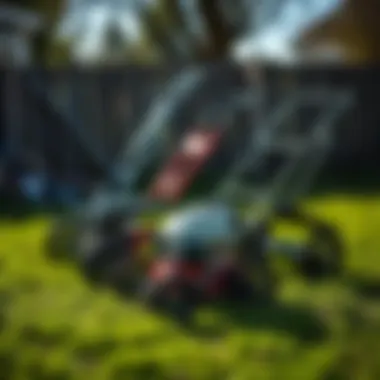
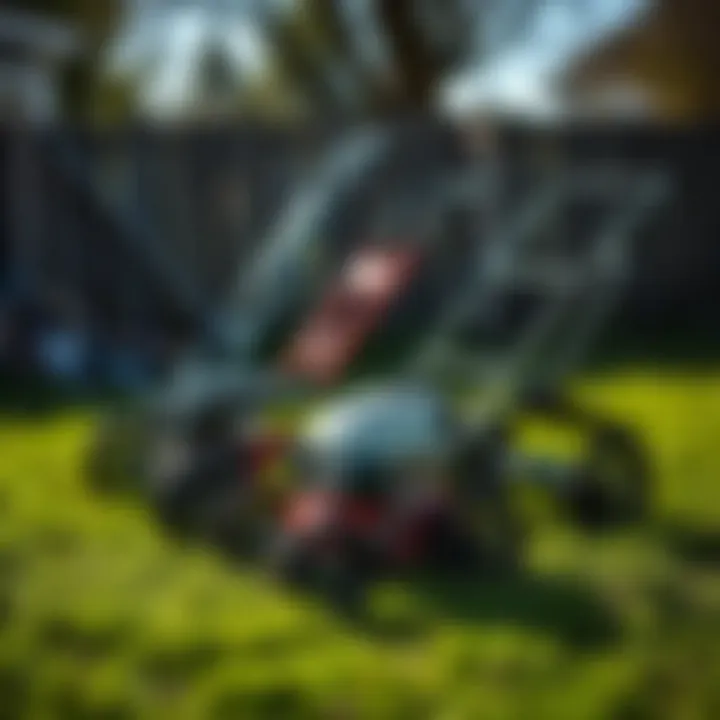
Think about it this way: Imagine you're staring at your lawn, grass thick with thatch—waiting for you to take action. With a manual rake or dethatching machine, it might take hours, if not a whole weekend. Yet, with an auto dethatcher, much of that time can be trimmed down significantly. When you're able to complete this process in a fraction of the time, it allows you to focus on other vital lawn care tasks, such as seeding or aerating.
"Time is what we want most, but what we use worst."
– William Penn
Enhanced Lawn Health
The benefits of auto dethatchers extend far beyond just time. An adequately dethatched lawn shows significant improvements in overall health. Thatch, if left unchecked, serves as a barrier to essential nutrients and moisture, hampering the growth of the turf. By using an auto dethatcher, you can remove this buildup effectively, paving the way for healthier grass growth.
When the thatch layer is reduced, your lawn gets better airflow, allowing for a more robust root system. Additionally, when water and nutrients can penetrate the soil undisrupted, your grass grows lush and green. This results in a lawn that not only looks appealing but is also more resilient against pests and disease. Not to mention, a well-maintained lawn contributes positively to the environment. More grass means more oxygen produced and better air quality.
Cost Effectiveness
Lastly, it’s essential to consider the economic benefits of using an auto dethatcher. While the initial investment may seem steep, think of it as a long-term strategy for maintaining your lawn. The efficiency gained in both time and effort can translate into significant cost savings.
Consider the expenses associated with the additional labor if you were to hire professionals to handle dethatching. By owning an auto dethatcher, you minimize service costs and the frequency with which your lawn requires care. Also, a healthier lawn will reduce the need for costly chemical treatments or replacements, further enhancing your investment.
Selecting the Right Auto Dethatcher
Choosing the correct auto dethatcher is pivotal for anyone serious about lawn care. The effectiveness of your dethatching can vary significantly with the unit you select. A well-suited dethatcher not only makes the task easier but also enhances the overall health of the lawn. Getting it right means considering a few essential elements that can make or break your dethatching experience.
Factors to Consider
When it comes to selecting an auto dethatcher, there are numerous factors to keep in mind.
- Lawn Size: Assess the area you intend to dethatch. Larger lawns may benefit from gas-powered models that offer robust performance, while smaller spaces might only require an electric dethatcher.
- Power Source: Would you rather plug it in or refill gas? Electric dethatchers provide quiet, convenient use, but gas-powered options can handle thicker thatch and are usually more potent.
- Weight and Maneuverability: Consider how easy it is to handle the machine. Heavier models may be harder to push, especially on uneven ground. A lighter option could save you from unnecessary strain.
- Adjustable Height Settings: Dethatchers with adjustable height settings allow for more precision based on lawn type. Being able to set the right depth can help protect your turf from damage while removing just the right amount of thatch.
- Budget: Set a realistic budget before diving into the market. Auto dethatchers vary significantly in price. Finding a reliable model that best fits your pocket is essential.
Keep these considerations in mind: making the wrong choice can lead to headaches and a less effective lawn maintenance regimen.
Top Brands on the Market
When it comes to trusted brands in the auto dethatcher market, a few stand out for their quality and customer satisfaction.
- Sun Joe: Known for producing electric dethatchers that are user-friendly and cost-effective, Sun Joe models are suitable for residential lawns.
- Toro: Their versatile line offers both gas and electric options, making Toro a favorite for professional landscapers and homeowners alike.
- Craftsman: A reputable name in the lawn care industry, Craftsman’s dethatchers are regarded for durability and ease of use.
- Husqvarna: If you're looking for robust performance and reliability, Husqvarna has options that cater to both small and large lawns.
- Greenworks: A brand focused on eco-friendliness, they offer electric dethatchers that are perfect for environmentally conscious gardeners.
Choosing from these reputable brands can provide a solid base for your purchase, as they're generally well-reviewed and trusted by many in the lawn care community.
Always remember, investing in a quality dethatcher is a step in the right direction towards achieving the lawn of your dreams.
This selection process is not just about finding a machine; it’s about paving the way for a healthier garden that flourishes season after season.
Best Practices for Dethatching
Dethatching is not just a chore; it’s a pivotal practice for earning your turf back its resilience and vibrancy. Following best practices, particularly around timing and techniques, can make a world of difference to the health of your lawn. Knowing the optimal moments to tackle thatch buildup, along with the proper methods, helps your efforts not go to waste. This section will offer clear guidance on how to carry out dethatching effectively and in a timely manner.
Timing for Dethatching
Getting the timing right can mean the difference between a flourishing lawn and a puny patch of grass. The best time to dethatch your lawn is during the growing season, typically in late spring to early summer for cool-season grasses, and late spring to early fall for warm-season varieties. Timing it just right allows the grass to recover quickly, promoting hearty growth after dethatching.
To gauge the right moment, consider the following:
- Grass Type: Know whether your grass is cool or warm season. This will determine the best time of year.
- Soil Moisture: Aim for a slightly moist soil. Too dry, and you risk damaging the roots; too wet, and you could churn up a muddy mess.
- Weather Pattern: A few days of mild weather post-dethatching will aid the grass to bounce back.
When you find that goldilocks zone of moisture and temperature, your chances of success just skyrockets.
Techniques for Optimal Results
Once you've nailed the timing, it’s time to roll up your sleeves and get into the nitty-gritty of dethatching techniques. Here’s where you can optimize the potential of your auto dethatcher:
- Prepare the Surface: Start by mowing your grass lower than normal before dethatching. This reduces any excess height and makes it easier for the dethatcher to penetrate the thatch layer.
- Overlap Passes: While using the dethatcher, make sure to slightly overlap each pass. This technique assures that you don’t leave any patches untouched.
- Adjust Depth Setting: Depending on the condition of your lawn, adjust the dethatcher’s depth setting. A deeper setting might be needed for thicker thatch, while a shallower one can suffice for lighter buildup.
- Rake Afterwards: After running the dethatcher, you might want to rake up the debris. This not only clears the surface but also allows for better airflow to the roots.
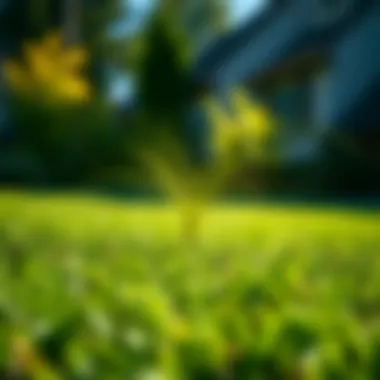

Incorporating these techniques establishes a strong foundation for a healthy lawn as they focus on enhancing soil health and microbial activity, leading to strong root development and reduced disease susceptibility.
"Dethatching isn't just cleanup; it's rehabilitation for tired turf."
Following these best practices, homeowners and professionals alike can ensure that they are approaching dethatching not just as a routine task, but as a vital step toward encouraging a vibrant, healthy lawn. Remember, the road to a thriving green space begins with understanding and implementing these practices.
Environmental Considerations
When shifting focus toward lawn care, it becomes increasingly important to recognize the environmental implications that accompany our gardening practices. Particularly, the use of auto dethatchers plays a vital role not only in detoxifying our lawns but also in making them sustainable. In this section, we will delve into the fundamental aspects of sustainable yard management and the emphasis on minimizing chemical usage which directly aligns with sustainable practices.
Sustainability in Lawn Care
Choosing sustainable methods in lawn care is akin to nurturing the environment alongside growing lush greenery. Sustainability is about finding a balance between fostering healthy lawns and maintaining the ecological integrity of the surroundings. An eco-friendly approach to lawn care, facilitated by auto dethatchers, can radically transform traditional yard management practices.
Using auto dethatchers can often reduce the need for chemical fertilizers and pesticides, as a well-maintained lawn promotes healthier root systems and natural pest resistance. The dethatching process naturally aerates the soil, allowing for better water absorption and nutrient assimilation, ultimately enhancing soil health over time.
Moreover, sustainable practices reduce the burden on landfills because gardeners become less reliant on synthetic materials. By opting for organic compost and natural fertilizers instead, one contributes not only to a healthier garden but also helps mitigate environmental degradation. This responsible management nurtures biodiversity, encouraging beneficial insects and wildlife rather than deterring them with harmful chemicals.
Reduction of Chemical Use
In the conversation surrounding environmental considerations, the reduction of chemical use is perhaps one of the most pressing topics. Prevailing practices often involve the application of chemical fertilizers and herbicides, which can do more harm than good in the long run. By employing auto dethatchers, a natural approach can be taken instead.
The process of dethatching reduces the need for high volumes of chemical treatments, as healthy lawns require fewer interventions. This not only lessens the risk of chemical runoff into nearby water sources but also minimizes the potential impact on human health. For instance, children and pets frequently play on lawns; thus, reducing exposure to chemicals is both prudent and responsible.
Several techniques complement the use of auto dethatchers in minimizing chemical use:
- Organic Composting: Applying organic compost enriches the soil naturally, providing necessary nutrients without synthetic additives.
- Regular Maintenance: Routine dethatching can prevent thatch build-up, reducing reliance on chemical herbicides.
- Natural Pest Control Options: Employing beneficial microorganisms and companion planting can also limit the need for commercial pesticides.
In essence, the transition towards environmentally-friendly lawn care techniques, specifically through the use of auto dethatchers, paves the way for healthier ecosystems. Every small step taken can contribute to a larger movement towards sustainability.
This holistic view around lawn care underlines the importance of being conscious of our choices, reinforcing the notion that not only do we cultivate our gardens, but we also cultivate a better world.
User Experiences and Testimonials
User experiences and testimonials hold significant weight in understanding how auto dethatchers truly perform in real-world scenarios. While specifications and features outlined by manufacturers provide some insight, it’s the stories of users, be they professional landscapers or homeowners, that paint the full picture. These narratives can reveal both the advantages and the possible downsides of using an auto dethatcher, thus equipping readers with a balanced view that goes beyond mere technical specifications.
Professional Landscapers' Insights
When it comes to lawn care, professionals are often regarded as the gold standard. Their insights can help demystify the usage of auto dethatchers in complex lawn care strategies. For instance, a landscape expert from South Carolina shared how using an electric dethatcher cut down their time spent on maintenance by nearly 30%. They specifically noted how the machine’s efficiency allowed them to focus more on other crucial tasks like aerating and patching bare spots, hence improving overall job quality.
Furthermore, professionals often emphasize the importance of understanding the types of thatch prevalent in different areas before choosing a dethatcher. For example, a landscaper may mention how using a gas-powered dethatcher for a particularly thick layer of thatch served them well. Their experience underscores the necessity of matched tools to specific challenges; it’s not a ‘one-size-fits-all’ scenario.
"The right dethatcher can elevate your landscaping game. But choosing it isn’t just about power; it’s knowing how it fits into your workflow." – Landscape Professional from Atlanta.
Homeowner Feedback
Homeowners also offer valuable perspectives, particularly those who tackle lawn care as a passion rather than a profession. Many homeowners report that auto dethatchers have transformed the way they approach their lawns. A homeowner in Oregon shared their journey of previously laboring over manual dethatching, often leading to sore muscles and lackluster results. After switching to an auto dethatcher, they discovered a newfound satisfaction in maintaining their yard, claiming that the lush green results made their efforts apparent and rewarding.
In contrast, some homeowners caution against the ease of use that auto dethatchers provide. A user from Minnesota suggested that new users should still do a bit of research and practice before diving into extensive usage. The ease of operation can be misleading, and improperly using the machine may lead to damage of the lawn rather than benefits. This perspective emphasizes the importance of education in tandem with technology.
In sum, user experiences shed light on practical aspects of auto dethatchers, informing potential buyers about the capabilities and precautions linked to these machines. Whether it’s from a seasoned professional or an enthusiastic homeowner, testimonials offer an invaluable mix of reliability and realism that technical data alone cannot provide.
Epilogue
In wrapping up our exploration of auto dethatchers, it becomes evident that these tools are not just luxuries but essential components of modern lawn care. The critical role they play serves to enhance the health and resilience of turf, making them indispensable for those who value a lush green landscape.
The Future of Lawn Care
As we peer into the future of lawn care, the presence of auto dethatchers will only become more pronounced. There’s growing recognition of the interplay between ecological sustainability and effective landscaping practices. With every twist of a dethatcher blade, we are not just removing dead grass, but fostering biodiversity beneath the surface. Efforts are underway to integrate smart technology into these machines, allowing for real-time monitoring and adjustments based on soil health and moisture levels. This shift means that enthusiasts and professionals alike can expect their auto dethatchers to evolve alongside advancements in technology, optimizing their lawn care strategies even further.
The trends toward eco-friendly landscaping will likely spur innovation in dethatcher design and functionality. We anticipate machines that consume less fuel, reduce noise pollution, and even utilize renewable energy sources. These adaptations will align with a broader commitment to sustainability within the agricultural community, offering solutions that harmonize lawn aesthetics with environmental stewardship.
Final Thoughts on Auto Dethatchers
Before we conclude, it’s prudent to appreciate the multifaceted benefits of using auto dethatchers. These machines do not just simplify a chore; they embrace the very essence of lawn maintenance by encouraging healthier turf while decreasing the reliance on chemical treatments. Regular dethatching contributes to a vibrant lawn ecosystem that promotes better air circulation and moisture retention.
What stands out is that the right auto dethatcher, when chosen wisely, aligns with specific lawn needs and user capabilities. Investing in quality and functionality means you’re laying the groundwork for enduring lawn health and beauty. Whether you’re a seasoned professional or a weekend warrior, the role of these auto dethatchers offers a clear pathway to achieving your lawn care goals with precision and efficiency.







